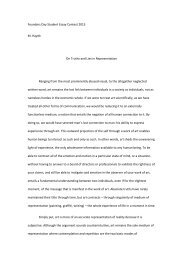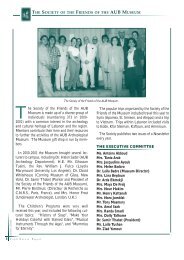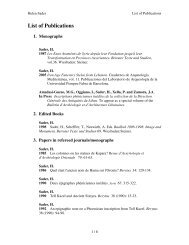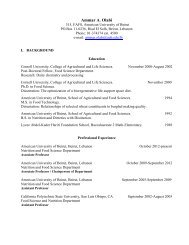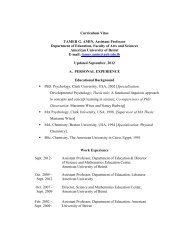The IX t h Makassed Medical Congress - American University of Beirut
The IX t h Makassed Medical Congress - American University of Beirut
The IX t h Makassed Medical Congress - American University of Beirut
You also want an ePaper? Increase the reach of your titles
YUMPU automatically turns print PDFs into web optimized ePapers that Google loves.
PREVENTION OF HUMAN PAPILLOMA VIRUS INFECTIONS: CHALLENGES AND<br />
PROMISES<br />
Ghassan Dbaibo M.D<br />
Human papilloma virus (HPV) infections are exceedingly common in women and men. <strong>The</strong><br />
oncogenic types are responsible for all cervical cancers and a large proportion <strong>of</strong> other<br />
anogenital cancers in women as well as in men. Non-oncogenic types cause skin and genital<br />
warts and represent a significant burden on affected individuals. Prevention <strong>of</strong> four <strong>of</strong> the most<br />
common HPV’s is now possible with vaccination. Studies have shown that vaccination is effective<br />
in preventing infection with HPV, preventing persistent infection with HPV, and preventing<br />
development <strong>of</strong> pre-cancerous lesions <strong>of</strong> the cervix as well as the vulva and the vagina. Although<br />
vaccination is highly effective, uptake <strong>of</strong> the vaccine has been slow due to several barriers.<br />
<strong>The</strong>se barriers and possibilities to overcome them will be discussed.<br />
ANTI-CD20 MONOCLONAL ANTIBODIES FOR THE TREATMENT OF LYMPHOID<br />
MALIGNANCIES AND AUTOIMMUNE CYTOPENIAS<br />
Tadeusz Robak, MD<br />
Over the last few years several monoclonal antibodies (mAbs) have been investigated in<br />
clinical trials in patients with lymphoid malignancies and autoimmune disorders [1]. <strong>The</strong> most<br />
important clinical value have at present rituximab (IDEC C2B8, Rituxan, Mabthera) that targets<br />
CD20 antigen and alemtuzumab (Campath-1H), a humanized form <strong>of</strong> a rat antibody active<br />
against CD52. <strong>The</strong> CD20 antigen is expressed on almost all B-cells but the intensity <strong>of</strong> expression<br />
appears to be lower on chronic lymphocytic leukemia (CLL) cells than in patients with non-<br />
Hodgkin lymphoma (NHL). <strong>The</strong> intensity <strong>of</strong> antigen expression or the number <strong>of</strong> receptor sites<br />
on the cell surface appears to be correlated with the clinical response. Rituximab is an IgG1<br />
kappa immunoglobulin containing murine light – and heavy chain variable region sequences<br />
and human constant region sequences. <strong>The</strong> Fab domain <strong>of</strong> rituximab binds specifically to the<br />
CD20 antigen expressed on normal and malignant B-cells. <strong>The</strong> Fc domain recruits immune effect<br />
or functions to mediate B-cell lysis in vitro and in vivo. Mechanism by which rituximab may<br />
be cytotoxic include complement dependent cytotoxicity (CDC), antibody-dependent cell<br />
mediated cytotoxicity (ADCC) and induction <strong>of</strong> apoptosis. Furthermore, rituximab sensitizes<br />
malignant B-cells to the cytotoxic effects <strong>of</strong> chemotherapy. Rituximab was the first mAb approved<br />
in 1997 by the Food and Drug Administration (FDA) for the treatment <strong>of</strong> cancer. <strong>The</strong> drug is<br />
usually administered as an intravenous infusion with a recommended dosage 375 mg/m 2 given<br />
once weekly for 4 weeks. Treatment with this agent is well tolerated. However, infusion-related<br />
reactions occur in the majority <strong>of</strong> patients, although the incidence <strong>of</strong> these side effects decrease<br />
with subsequent rituximab infusion. Rituximab is currently validated as first-line treatment for<br />
aggressive and indolent subtypes <strong>of</strong> B-cell non-Hodgkin lymphoma (NHL). In diffuse large B-cell<br />
lymphoma (DLBCL) R-CHOP (Rituximab + CHOP) has became the new standard <strong>of</strong> care, which<br />
led to improve outcomes for this lymphoma [2]. <strong>The</strong> addition <strong>of</strong> rituximab to chemotherapeutic<br />
combinations (CHOP or CVP (cyclophosphamide, vincristine, prednisone) has also resulted in<br />
a significant increase in overall response rate (ORR), complete response rate (CR) and time to<br />
progression (TTP) in patients with follicular lymphoma [FL] [3]. In relapsed/resistant FL rituximab<br />
maintenance considerably improves progression free survival (PFS) not only after CHOP but also<br />
73






